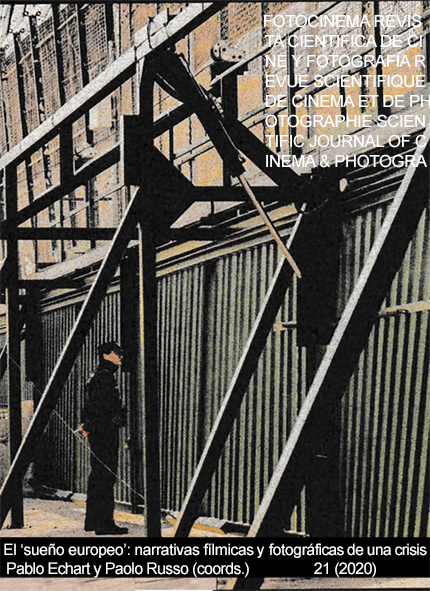Aeneas of the 21st century: narratives of the migratory crisis in comics published in Spain (2014-2019)
DOI:
https://doi.org/10.24310/Fotocinema.2020.vi21.10007Keywords:
Comic, immigration, narrative, stereotypes, color, drawnAbstract
The migrant crisis that has affected Europe since at least 2014 is a topic of interest for the media in countries that receive the largest number of migrants, mainly Spain, Italy and Greece. There is an abundance of journalistic reports and films about the phenomenon, perhaps because these are means of wide dissemination. Nonetheless, they can be considered approximations within the framework of audiovisual representations of social phenomena. This article focuses on a less-attended medium, the comic, in one particular country, Spain, which in 2019 received more than 23,000 migrants. A set of 13 titles has been located: published between 2014 and 2019, these reflect on migration through stories that emphasize concepts such as flight, border and confinement. This article analyzes these comics from a semiotic point of view to define the iconography, the literary expression and the narrative techniques that are employed to represent migration.
Downloads
Metrics
Publication Facts
Reviewer profiles N/A
Author statements
Indexed in
-
—
- Academic society
- N/A
- Publisher
- Universidad de Málaga
References
Arango, J. (2007). Las migraciones internacionales en un mundo globalizado. Vanguardia Dossier, 22, p. 6-15.
Arango, J., Moya Malapiedra D. & Alonso, J.O. (dir.) (2014). Inmigración y emigración: mitos y realidades. Barcelona: CIDOB.
Bryant, M. (2008). La II Guerra Mundial en cómic. Madrid: Libsa.
Carleton, S. (2014). Drawn to Change: Comics and Critical Consciousness. Labour / Le Travail (73), 151-177. Disponible en: https://www.jstor.org/stable/24244249?seq=1#metadata_info_tab_contents
Catalá-Carrasco, J.L. (2017). Neoliberal expulsions, crisis, and graphic reportage in Spanish comics. Romance Quarterly, 4 (64), 172-184. DOI: https://doi.org/10.1080/08831157.2017.1356139
McCloud, S. (2007). Entender el cómic. Bilbao: Astiberri.
Czaika, M. y De Haas, H. (2014). The Globalization of Migration: Has the World Become More Migratory? International Migration Review, 2 (48), 283-323. DOI: https://doi.org/10.1111/imre.12095
D'Angelo, M., & Cantoni, L. (2006). Comics: Semiotics Approaches. En K. Brown (Ed.), Encyclopedia of Language and Linguistics Vol. 2: 627-635. Oxford (GB): Elsevier.
Eisner, W. (2007). El cómic y el arte secuencial. Barcelona: Norma.
Estadísticas OIM (2017). Disponibles en: www.epdata.es/datos/inmigracion-ilegal-espana-grecia-italia-fallecidos-mediterraneo/156
Estudio de Amnistía Internacional (2017). Disponible en: www.care.org/emergencies/syria-crisis
Fernández Navarrete, D. (2019). Historia de la UE. De los orígenes al Brexit. Madrid: UAM Ediciones.
Gadea, M.E. & Torres, F. (2015). Crisis, inmigración y sociedad. Madrid: Talasa.
Galeote, M. (2017). Desplazamiento, emigración, exilio. En “Exilio, migraciones, asilo y desplazamientos forzados”. Transatlantic Studies Network, 2 (4), 31-38. Málaga: Universidad de Málaga.
Gasca, L. y Gubern, R. (2001). El discurso del cómic. Barcelona: Cátedra.
Groensteen, T. (1999). Systeme De La Bande Dessine?e. París: Presses Universitaires de France.
Gubern, R. (1972). El Lenguaje de los cómics. Barcelona: Península.
Informe Tebeosfera (2018). Disponible en: www.tebeosfera.com/anexos/informe_tebeosfera_2018.pdf
Informe del Sector Editorial en España (2018). Disponible en: www.federacioneditores.org/datos-estadisticos.php
Marcos Ramos, M. & Rubio Alcover, A. (2018). Una misión irrenunciable. Refugiados y desplazados: representación en el audiovisual. En “Refugiados y desplazados: representación en el audiovisual”. Archivos de la Filmoteca, 75, 13-18. Disponible en http://www.archivosdelafilmoteca.com/index.php/archivos/article/view/652/606
Massimo, F. (2017). El asedio. Madrid: Editorial Popular.
Mey, K.-A. L. (2006). Comics: Pragmatics. In K. Brown (Ed.), Encyclopedia of Language and Linguistics Vol. 2: 623-627. Oxford (GB): Elsevier.
No?th, W. (1990). Handbook of Semiotics. Indianappolis (EE.UU.): University of Indiana Press.
Parutis, V. (2014). “Economic Migrants” or “Middling Transnationals”? East European Migrants´ Experiences of Work in the UK. International Migration, 1 (52), 36-55. DOI: https://doi.org/10.1111/j.1468-2435.2010.00677.x
Petersen, R.S. (2010). A History of Graphic Narratives. Westport (Connecticut, EE.UU.): Praeger.
Priego, A. (2011). La primavera árabe: ¿una cuarta ola de democratización? Revista UNISCI, 26, 75-94. Disponible en: https://www.redalyc.org/pdf/767/76718800004.pdf
Proyecto Missing Migrants (2018). Disponible en: www.epdata.es/datos/inmigrantes-muertos-desaparecidos-mediterraneo-camino-europa/85
Salinas de Frías, A. y Martínez Pérez, Enrique J. (dir.) (2018). La Unión Europea y la protección de los Derechos Fundamentales. Valencia: Tirant lo Blanch.
Szmolka, I. (2013). El conflicto del Sáhara Occidental en el marco de la Primavera Árabe. Revista de Investigaciones Políticas y Sociológicas, 2 (12), 45-64. Disponible en: https://www.redalyc.org/pdf/380/38029545001.pdf
Trilling, D. (2018). Lights in the Distance. Londres: Picador.
Trilling, D. (2018). Five myths about the refugee crisis. Publicado en The Guardian el 5 de junio de 2018. Disponible en: www.theguardian.com/news/2018/jun/05/five-myths-about-the-refugee-crisis
Virgilio (2019). Eneida. Barcelona: Gredos.
Zaccara, L. y Saldaña, M. (2015). Cambio y estabilidad política en las monarquías del Golfo tras la Primavera Árabe. Revista CIDOB d’Afers Internacionals, 109, 177-199. Disponible en: https://www.jstor.org/stable/24364607?seq=1#metadata_info_tab_contents
Zizek, S. (2016). La nueva lucha de clases. Los refugiados y el terror. Barcelona: Anagrama.
Downloads
Published
How to Cite
Issue
Section
License
All contents published in Fotocinema Revista científica de cine y fotografía are protected under the Creative Commons Attribution-NonCommercial-ShareAlike 4.0 International (CC BY-NC-SA 4.0) license. All about this license is available in the following link: <http://creativecommons.org/licenses/by-nc-sa/4.0>
Users can copy, use, redistribute, share and exhibit publicly as long as:
- The original source and authorship of the material are cited (Journal, Publisher and URL of the work).
- It is not used for comercial purposes.
- The existence of the license and its especifications are mentioned.
There are two sets of authors’ rights: moral and property rights. Moral rights are perpetual prerogatives, unrenounceable, not-transferable, unalienable, imprescriptible and inembargable. According to authors’ rights legislation, Fotocinema. Revista científica de cine y fotografía recognizes and respects authors moral rights, as well as the ownership of property rights, which will be transferred to University of Malaga in open access. The property rights are referred to the benefits that are gained by the use or the dissemination of works. Fotocinema. Revista científica de cine y fotografía is published in an open access form and it is exclusively licenced by any means for doing or authorising distribution, dissemination, reproduction, , adaptation, translation or arrangement of works.
Authors are responsable for obtaining the necessary permission to use copyrighted images.














13.png)



